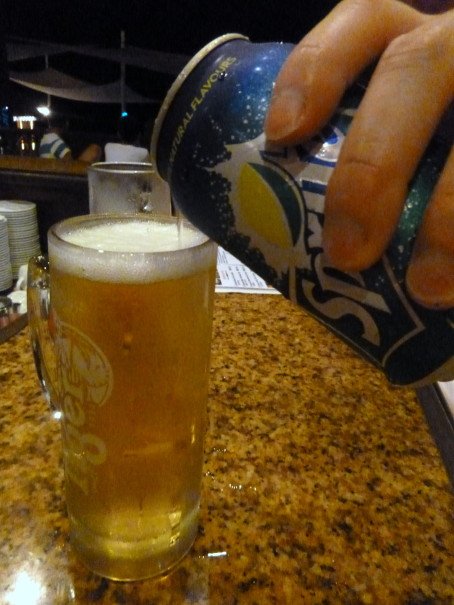
From Lager to Ale and Back Again

From Lager to Ale and Back Again
A Tiger Topped in Malaysia
Growing up in Australia in the 90s, the word “beer” meant only one thing: a fridge-cold, heavily (and artificially) carbonated, slightly bitter, golden-colored, hopped alcoholic beverage, typically consumed from a can or a short, squat bottle known as “a stubbie.”
It was only years later, when I finished uni and moved to London for work, that I discovered that, in the mother country, the word “beer” could mean either of two separate and distinct things: lager—which is what we in Australia simply call beer—or ale. Ale is only naturally and lightly carbonated, is served at a cool room temperature and can never be consumed from a can. Unlike lager, ale undergoes a special process called “secondary fermentation” whereby it is left to slowly mature in its cask.
As you’ve probably guessed by now, I very quickly took to ale. But, by the early 70s, ale, like pretty much everything else in Britain, had fallen on hard times. In 2013, ale made up just 8.2 per cent of total UK beer sales. Thus, I soon discovered that my English mates—most of whom were ordinary, twirtysomething, football- and beer-loving English lads—did not share my newfound enthusiasm for ale. They drank sterile, multinational lagers. Foster’s—the Australian beer that no one in Australia actually drinks—was a particular favorite.
The very first time that I ventured out to Selhurst Park to watch my mate’s local football club play a home game, he took me to a pub for a pre-game beer. I wasn’t at all surprised when he ordered each of us a pint of Foster’s. I was surprised when I took a sip and discovered that it didn’t taste quite as bland as Foster’s normally does. I asked him about it and he explained that he had ordered us “Foster’s topped.”
“What’s it topped with?” I asked.
“Lemonade,” he said.
I was shocked. In Australia, beer is never mixed with any other beverage, and certainly not an effeminate soft drink like lemonade. If you tried to top your post-game beer with some lemonade at an Australian cricket or footy club, you’d probably get your head kicked in. Yet, here we were, in a proper, working-class British football supporters’ pub—the kind of pub where “NO COLOURS” is written in white chalk on a blackboard out the front—and I was surrounded by manly men drinking lager topped with lemonade.
My only previous experience of beer mixed with lemonade had come on family trips to Malaysia—the country where my parents were born and raised—where cold cans of shandy—beer pre-mixed with lemonade—is a popular ladies’ drink. One of my earliest childhood memories of Malaysia is the infamous Chinese New Year of 1992, when one of my Malaysian aunts got so drunk sinking cans of the local Jolly-brand shandy that she jumped into her Merc and went AWOL on a midnight joyride. A family search party of five cars went out to find her. She returned the next morning unscathed.
The problem with Malaysian shandy is that it contains too much lemonade and not enough beer. Jolly shandy, one of the most popular brands in Malaysia, only has one per cent alcohol. That, and the fact that it’s a girl’s drink, put me off it.
Ever since I’d reached drinking age, my personal tipple of choice when in Malaysia had always been an ice-cold Tiger beer. In Singapore and Malaysia, Tiger—a Singaporean brew and brand—is as ubiquitous as Coca-Cola. Anthony Burgess even titled the first book of his Malayan trilogy Time for a Tiger. As far as mass-produced commercial lagers go, Tiger is a solid beer—crisp, clean and refreshing, it goes down well in the hot, brutally sticky Malaysian climate where the humidity hovers around 70 per cent all year round.
But, I’d always felt that it lacked a little something. When enjoyed with Malaysia’s wonderfully spicy, rich, and pungent food, it was just a bit too plain. What Tiger beer needed was a touch of extra acidity—preferably citric in origin—to cut through the richness of Malaysian food.
The solution hit me on my very first trip back to Malaysia after moving to London. I cracked open an ice-cold can of Tiger from my fridge, filled 95 per cent of my glass with Tiger, and topped the remaining 5 per cent with some Sprite. I christened the drink a “Tiger topped.” It is my greatest—well, only—invention. I never drink it outside Malaysia, but it’s all I ever drink in Malaysia. It provides all the smooth, easy-drinking refreshment and alcoholic relaxation of a bog-standard Tiger beer, plus a distinct note of extra citric acidity and a hint of extra sweetness, which makes it a far superior complement to Malaysian food and just that little bit more refreshing.